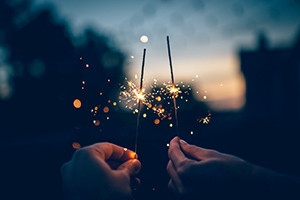
“When in the Course of human events, it becomes necessary for one people to dissolve the political bands which have connected them with another, and to assume among the powers of the earth, the separate and equal station to which the Laws of Nature and of Nature's God entitle them, a decent respect to the opinions of mankind requires that they should declare the causes which impel them to the separation.” These are the opening words of the Declaration of Independence and with these words our nation was born on July 4, 1776.
This time of year, we mark that declaration with celebrations, picnics, friends and fireworks. And for most, the days around the 4th are spent relaxing and being with family. But for many in the fire and investigation services, the 4th of July also brings extra work from people using fireworks.
Fireworks start an average of 18,500 fires per year, including 1,300 structure fires, 300 vehicle fires, and 16,900 outside and other fires. These fires cause an average of $43 million in direct property damage. And while many states and localities have outlawed fireworks in some manner or another, the damage done from people misusing fireworks has not decreased in recent years.
To understand the problem, we need to look at the types of fireworks and causes of these fires. There are two grouping of fireworks. The first type includes fountains, sparklers and smoke bombs, which are legal in many municipalities and can be found for sale on many street corners during the holiday. When used as directed, these fireworks can generally be considered safe – the key is using them as directed. The second group of fireworks includes mortars, rockets, firecrackers and roman candles, which will leave the ground and/or explode. While many states have laws in place that allow the sale of these devices, most areas outlaw their use.
Fires caused by fireworks generally happen for one of three reasons:
- Combustibles were too close to the fireworks
- Firework remains were improperly disposed
- Fireworks landed on combustible materials
Sparklers and fountains, while typically safe, can create problems when people either use them in manners not intended or in a location close to combustibles. Many fires have occurred when the person using them decides to light the fireworks next to wood chips or close to a building. One fire recently investigated was caused when the teenage occupants decided to have a “sparkler war” and were lighting sparklers and throwing them at each other. The ensuing trip to the emergency room caused that game to come to a quick end.
Many fires have occurred when the homeowner is done with their festivities and decides to clean up the remains. Most people do not realize the need to soak remaining cardboard tubes in water before placing in a trash can. Due to the types of chemicals and materials used to make the sparks and colors, the tube is treated in a manner so the fire sprays from the end and does not just explode. Once the fireworks have finished, embers can sit inside the tube for a considerable amount of time. If the homeowner places these tubes, boxes and papers inside their trash bin, the glowing embers can now ignite other fuels. Unified Investigations has been called to assess many of these fires where the homeowner placed the full can either next to the building or inside the garage. The ensuing fire then creates another show for the neighborhood that no one wants to see.
The axiom of what goes up must come down also relates to fireworks. When people send bottle rockets, mortars, etc. into the air, they have no idea where they will come down. And, like their legal counterparts, these devices will be hot when they land. One fire investigated by Unified was the result of falling bottle rockets that lit the roof of a barn on fire. Neighbors saw the fire while it was still small, but due to its location, efforts to extinguish it were in vain. The fire destroyed the barn and the house next to it. During the investigation, multiple dozens of rocket remains were noted on the ground and houses surrounding the involved building. All the fireworks were sent skyward by one house in the neighborhood having a party. The homeowner having the party ended up with both criminal and civil charges because of the incident.
When investigating firework-related fires, the investigator needs to account for not just the actions of those involved, but also the actions of people down the block. A neighborhood canvas will assist in determining the location where the fireworks originated and possible responsible parties for subrogation. The scene examination should also reveal the presence of the firework containers and tubes.
We at Unified hope you have a safe and peaceful 4th of July weekend. If you choose to do so, please enjoy fireworks responsibly.
Kevin Reilly, IAAI – CFI, Senior Investigator